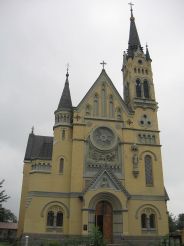Church of St. John the Baptist

Roman Catholic Church of St. John the Baptist is located in the heart of the White Church. According to ancient tradition is in its place stood the very white church, from which the town got its name. The church was built on Castle Hill in 1813 with funding from Count Xavier Branitski. Later, the church became the burial place of the family of a noble family Branickis.
The building is a prime example of classical Catholic architecture and is made in the form of a Latin cross, which is located along a straight axis in the east-west direction. The eastern part of the cross is a semi-circular apse, and in the western part of the tower. Antique clock with bells mounted on one of the towers, and another crown six bells. Church is a two-tier structure with a height of 27 meters, width - about 25, and the length - 35 meters.
Particularly impressive is the interior of the church. Its walls are decorated with stucco, made in the form of complex patterns and openwork outlets. To this day, preserved information about the cost of such a sculpture, made by Italian craftsmen, much higher than the cost of the temple. The ancient walls of the church preserved paintings, painted by an unknown artist. One of the walls is decorated with white marble stele erected in honor of Catherine Branicka-Sangushko. Floor is covered with multi-colored plates, made of the best marble.
In Soviet times the church was closed for the congregation, worship here temporarily resumed during the Nazi occupation, but after the war it was closed again. In the postwar decades, the church building was equipped lecture hall, and then the warehouse.
In 1964, the Roman Catholic Church of St. John the Baptist restoration was carried out. Today, the walls of the church is the house of organ and chamber music. There are organized diverse classical music concerts, attracting artists and audiences from around the world.
Photos:
Tours and excursions



















